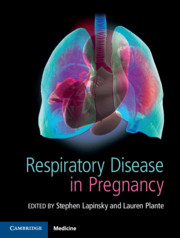Book contents
- Respiratory Disease in Pregnancy
- Respiratory Disease in Pregnancy
- Copyright page
- Contents
- Contributors
- Section 1 The Basics: for the Obstetrician
- Section 2 The Basics: for the Non-Obstetrician
- Section 3 Pulmonary Conditions Not Specific to Pregnancy
- Section 4 Pulmonary Conditions Related to Pregnancy
- 16 Dyspnoea of Pregnancy
- 17 Amniotic Fluid Embolism Syndrome
- 18 Pregnancy-Associated Pulmonary Oedema
- Section 5 Other Pulmonary Issues in Pregnancy
- Index
- References
16 - Dyspnoea of Pregnancy
from Section 4 - Pulmonary Conditions Related to Pregnancy
Published online by Cambridge University Press: 14 April 2020
- Respiratory Disease in Pregnancy
- Respiratory Disease in Pregnancy
- Copyright page
- Contents
- Contributors
- Section 1 The Basics: for the Obstetrician
- Section 2 The Basics: for the Non-Obstetrician
- Section 3 Pulmonary Conditions Not Specific to Pregnancy
- Section 4 Pulmonary Conditions Related to Pregnancy
- 16 Dyspnoea of Pregnancy
- 17 Amniotic Fluid Embolism Syndrome
- 18 Pregnancy-Associated Pulmonary Oedema
- Section 5 Other Pulmonary Issues in Pregnancy
- Index
- References
Summary
Dyspnoea is a common complaint in pregnant women, and may occur as a result of the physiological changes in pregnancy or due to cardio-respiratory disease. A prospective observational study of 62 pregnant women identified that 76% experienced dyspnoea at some point during their pregnancy. Approximately half became symptomatic before 20 weeks’ gestation and the incidence increased until about 30 weeks’ gestation. It is important to be aware that some complications of pregnancy may produce dyspnoea in the previously well patient, so it is important to differentiate pathological conditions from this physiological dyspnoea. This chapter reviews the mechanisms of dyspnoea of pregnancy and the differentiation from pathological conditions.
- Type
- Chapter
- Information
- Respiratory Disease in Pregnancy , pp. 159 - 162Publisher: Cambridge University PressPrint publication year: 2020



